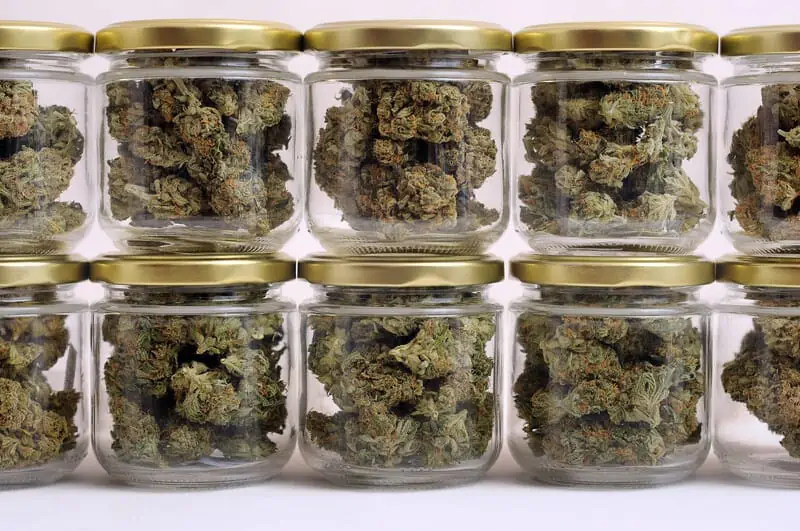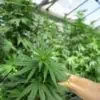TABLE OF CONTENTS
Identifying mold on cannabis isn’t as easy as spotting it on other food products.
Mold on cannabis can resemble white trichomes or be hidden in the crevices of the bud.
Keeping your stash free from mold is essential to having a safe experience.
Learn how to prevent marijuana mold.
Cannabis cultivation, whether it's for medical or recreational purposes, presents a unique set of challenges.
Among these, mold infestations are especially notorious due to their ability to decimate entire crops, thereby affecting yield quality and quantity.

What is Mold?
Mold is a type of fungal growth that thrives in damp environments and decaying organic matter.
Different species can have different colors. In optimal environments, mold releases tiny airborne spores that help it reproduce new mold colonies.
In cannabis cultivation, the prime culprits are often the Botrytis Cinerea (bud rot), Powdery Mildew, and various types of Aspergillus.
They can affect every growth stage of the plant, from seedlings to mature buds, and pose serious health risks when inhaled or consumed.
What Causes Marijuana Mold?
Mold can wreak havoc on cannabis through every stage of its life cycle, from its cultivation phase to storage.
In general, cannabis quality can be affected by heat, light, air, and moisture. All of these can contribute to an environment where mold can develop.
Here are the main causes of mold in cannabis:
- Poor airflow
- High humidity
- Temperature fluctuations
Mold proliferation is typically due to conducive environmental conditions. Therefore, regulating these is key to preventing mold growth.
Temperature and Humidity
Molds thrive in humid conditions and moderate temperatures. Maintaining the relative humidity below 50% and the temperature between 70-80°F can deter mold growth.
Ventilation and Air Circulation
Stagnant, humid air is a breeding ground for mold. Good air circulation ensures that there are no moist spots where mold can proliferate. Invest in fans and exhaust systems to promote good airflow.
Light
Ultraviolet (UV) light can kill mold spores. Certain UV light systems are designed specifically for mold control in cannabis cultivation.
Is It Safe to Smoke Moldy Cannabis?
Smoking moldy cannabis is not recommended. Will it kill you? Probably not. If you’re healthy, smoking moldy cannabis will most likely not make you feel sick.
What is the risks of consuming mold infested cannabis?
Moldy cannabis can taste harsh and cause a coughing fit, nausea, or even vomiting, but usually nothing more than that. However, if you have a mold allergy, it can cause sinus or lung inflammation. Watch out for the following symptoms:
- Congestion
- Wheezing
- Drainage
- Sinus pain
What are the risks of consuming moldinfested cannabis?
Smoking moldy cannabis when you have a compromised immune system or respiratory conditions can cause severe health consequences.
For instance, Cryptococcus, Aspergillus, and Mucor fungi can lead to severe and even lethal central nervous and respiratory system infections.
Signs of Marijuana Mold
Always look for signs of mold, even if you’ve purchased your buds from legal suppliers. Lab testing is the most accurate way to identify the presence and concentration of mold.
A low-powered microscope can help you tell the difference between mold and trichomes.
Trichomes are the sticky, translucent, or sometimes amber-colored resin glands on the buds. They are also found in lower concentrations on the stems and leaves.
A black-light can make mold appear a yellow or green color. Identifying and avoiding moldy cannabis can be done by looking for the signs of mold on marijuana.
Signs of mold on cannabis:
- Dampness
- White or gray fuzz
- Specks of dry white or gray powder
- Stale, musty, and foul smell
Can You Remove Marijuana Mold?
It’s not as simple as removing mold from cannabis. If you’re on the last of your stash, you may just want to cut off the moldy portion and use the rest, but you may still be consuming mold that isn’t visible to the naked eye.
Don’t take the risk of smoking moldy cannabis.
How to Prevent Marijuana Mold

Storage is a critical part of keeping your cannabis fresher for longer and preventing mold. As mentioned above, cannabis exposure to heat, humidity, light, and oxygen can create an optimal environment for mold to thrive.
Proper Watering Techniques
Overwatering is a common cause of mold in cannabis. It's crucial to ensure that plants are not left waterlogged, which can create a favorable environment for mold growth.
Irrigation Timing
Water plants early in the day so that they have time to dry off before the cooler, evening hours.
Drainage: Ensure that your plants have adequate drainage. Pots should have holes, and larger growing areas should be slightly tilted to allow excess water to drain off.
Regular Monitoring and Care
Regular inspection of your plants can help identify mold problems before they escalate. Use a magnifying glass to look for small patches of mold or mildew. Also, consider lab testing if you suspect the presence of mold but can't see it.
Hygiene and Quarantine
Mold spores can easily spread from one plant to another. Isolate any infected plants to prevent cross-contamination. Moreover, ensure that the grow room and tools are kept clean. Regular cleaning and disinfection can go a long way in preventing mold problems.
Use of Anti-fungal Agents
Organic antifungal agents such as neem oil, potassium bicarbonate, and hydrogen peroxide can help control mold. It's crucial to follow the manufacturer's instructions when using these products to avoid damaging your plants.
Do Not Store Cannabis in the Refrigerator or Freezer
Generally, storing cannabis in a refrigerator or marijuana freezer is not recommended because of the temperature and humidity fluctuations that can occur when you open and close the fridge or freezer door. Cannabis should be stored at temperatures of about 70º F.
Store Cannabis in an Airtight and UV-Protected Container
Glass jars are the classic storage option for cannabis plant material (bud, trim, stems, etc.) and the best way to prevent mold formation.
Mason jars or jars specifically designed for cannabis storage can reduce exposure to oxygen and moisture, preventing a damp environment.
Check out our list of the 7 best cannabis glass jar options to keep your buds fresh
Store Cannabis in a Cool, Dry, and Dark Place
Moisture, heat, oxygen, and direct exposure to light are all elements of the ideal environment for mold. Sun or artificial light exposure can speed up your bud’s natural degradation process and dry it out. A damp environment can cause an excess of moisture if a poorly sealed container.
To keep your cannabis fresh for a long time, keep it in a dry and dark area, like a pantry or closet, as long as it does not experience high temperatures.
Consider the Relative Humidity
The optimal relative humidity (RH) for cannabis is 59-63%. Higher humidity levels can lead to a damp environment where mold can thrive.
“
There are over 300,000 jobs in the cannabis industry. CTU trained me for one of them!

Makes $24.50 @ THC +
Humidity packs can regulate moisture levels within a container to achieve an optimal RH. A blend of salts and water removes or adds moisture to the environment as needed. Keep in mind that humidity packs must be replaced about every two months.
If you’re serious about humidity control and have extra cash to spare, humidors designed for cannabis storage are made from high-quality wood and protect buds and other cannabis products from moisture, light, and oxygen.
Final Thoughts on Preventing Mold on Weed
Moldy cannabis can ruin a good time. However, there are ways to identify mold's smell, look, and taste. Checking cannabis for mold before consuming it, especially for those with weak immune systems, is recommended.
Mold prevention in cannabis cultivation requires careful planning and regular monitoring. By creating an environment that is unfavorable for mold growth and by adopting hygienic practices, cultivators can significantly reduce the risk of mold infestations.
Remember, preventing mold is always easier and more cost-effective than dealing with an outbreak.
How do I keep my marijuana plants from molding?
Methods to Avoid Mold on Marijuana:
Use a hygrometer to measure the humidity and temperature in your growing area.
To keep the air flowing smoothly, install a fan and exhaust.
If the humidity level rises too much, install a dehumidifier.
Check plants frequently for disease symptoms.
Wherever possible, maintain a temperature of about 24°C.
How do you prevent mold when curing marijuana?
How to Avoid Mold Growth While Curing Cannabis:
During the first drying process, avoid using molds.
As the jars are curing, burp them.
Invest in a dehumidifier and a hygrometer.
Freezing the cannabis.
Storage bags with humidity control.

Luis Cordova
Luis Cordova is a distinguished author, and renowned expert in cannabis cultivation, who possesses a Master's degree in Plant Biotechnology and Pharmaceutical Science. As a valued contributor to highly esteemed publications such as Cannabis Training University and Maximum Yield Magazine, Luis has emerged as a trusted source of guidance and knowledge in the cannabis industry. Having written thousands of informative articles, Luis is widely recognized for his comprehensive expertise on cultivating cannabis, both indoors and outdoors.












 Jeff was involved in an accident where he endured a traumatic brain injury. He had a week-long stay in ICU where brain surgeons
Jeff was involved in an accident where he endured a traumatic brain injury. He had a week-long stay in ICU where brain surgeons  100% risk free money back guarantee within 48 hours after purchase if student has not completed any of the courses or exams.
100% risk free money back guarantee within 48 hours after purchase if student has not completed any of the courses or exams.